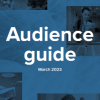Segmentation made simple
Contents
- What is segmentation?
- Why segment?
- So what does this mean for my organisation?
- What makes a useful segment?
- What are the criteria used for segmentation?
- How do I choose the best segmentation for my organisation?
Topics
A step-by-step guide to how getting started with segmentation can transform how you communicate with and market to your audiences.
Segmentation is an essential process to help arts and cultural organisations of all types, manage a range of relationships with their audiences. It forms a cornerstone of good marketing, communications, and audience development planning. So it’s worth taking some time and effort to get this right, for the benefit of your audiences, funders and other stakeholders, and your own long-term organisational resilience alike.
This guidance will walk you through getting to grips with the fundamentals and applications of audience segmentation, either using Audience Answers data about your own visitors, or taking a step back and looking at a national population picture through our mapping tool or templated reports.
What is segmentation?
Segmentation is simply the process of dividing and organising the population into meaningful and manageable groups – or segments - so that you can tailor your cultural offer and communications to the preferences of each group.
We often talk about ‘our audience’ but, in reality, we have multiple audiences with different expectations, who come for different reasons and behave in different ways. We need to be able to identify and understand the significant differences before we can respond to them. Segmentation enables us to do this in a coherent way.
Why segment?
If you want to persuade someone to do something (like attending an event), the more you know about them, the better your chances of success.
You can make sure, for example, that you tell them about something that interests them, or that you use their favoured means of communication, or even that you don’t put them off by telling them about something that they’re definitely not interested in.
The trouble is, not everyone is persuaded by the same things. Making assumptions about what all audiences/visitors want on the basis of what only SOME people do or say could limit the size and diversity of your audience. Segmentation helps make sense of these variations so that you can devise strategies to engage particular audiences based on the collective behaviours and characteristics that they share. It is, in effect, a recipe for reaching wider and different audiences, more often and more cost effectively.
So what does this mean for my organisation?
Segmentation needs to be workable for your organisation, based on things you can track and do something about.
The level of detail at which you segment needs to be appropriate to the level and variety of programme you are able to offer your audiences. Broadly speaking, large organisations with complex offers, bigger budgets, audiences and staff will need more intricate segmentation. Smaller organisations will require simpler ones.
What makes a useful segment?
We all like to think of ourselves as individuals, but it is not manageable for any organisation to treat each individual audience member as a separate segment.
So, part of the art of segmentation is to make judgements that are appropriate to your own situation. A useful checklist for identifying a segment should be:
- Relevant: are they identified by things that your organisation can respond to?
- Distinguishable: with characteristics demonstrably and measurably distinctive from other segments?
- Sizeable: does it encompass enough people to be worth the effort of targeting them?
- Locatable: once identified, do you have a way of being able to communicate with them directly?
What are the criteria used for segmentation?
There are lots of ways of segmenting an audience, and plenty of advice on doing so. The guidance here is simplified to make the most of the information you might have available.
Essentially it is a process of grouping people based on a combination of shared characteristics mapped in the following table:
| Insights | |
|---|---|
| Behavioural |
|
| Demographic |
|
| Geographical |
|
| Attitudinal |
|
How do I choose the best segmentation for my organisation?
A common question we hear at The Audience Agency, and quoted from other external research agencies and freelance consultants, is which segmentation in the arts and cultural sector is best for my audiences? Here's our advice on what to consider:
- It can be an expensive business. Of course, the best segmentation is always going to be one built bespoke for your organisation. Something created from detailed organisation-wide consultations, that has strong buy-in, from the board right down to the box office, and is as granular in its precision as it is straightforward in its maintenance… But that can take a lot of time and effort to produce and cost tens of thousands of pounds. Moreover, it can require a lot of staff time and coordination to get the whole team onboard, and often involves ongoing costs to keep it updated and relevant. The results are undeniably effective, but far from all cultural organisations are working with these kinds of resources.
- Start small with simple and direct objectives. A more realistic approach, then, starts from having just a few clearly articulated objectives for what you want your segmentation to achieve. Just as you would if you were commissioning a new website, embedding a new data system, or devising a new programme of events. If you start small, it is easier to integrate the segmentation model across your whole organisation, at each stage of the process – which is crucial to successful implementation.
- If your team isn’t speaking the same language, how can they talk to audiences? It is vital to ensure that you are thinking broadly across your organisation throughout deployment the process, about how the segmentation is understood and used across all audience-facing teams - from development to digital, marketing to front-of-house. Because, without understanding of the reasoning and buy-in from teams and individuals to the shared language, even the most bespoke and integrated segmentation can quickly fall flat… And still have cost a significant amount of staff time and budget.
- Make sure your objectives and segmentation insights can be applied organisation-wide. Whoever is driving the decision to start implementing segmentation as part of your audience development strategy – be it a grassroots effort or a stakeholder steer – the buy-in essential to success is only possible if everyone can see how this kind of granular insight can help progress their own team’s targets. This is a key objective of The Audience Agency's Audience Spectrum segmentation, which, developed in consultation with leading industry bodies and national funding figures, is designed to tell you more about the attitudes of groups of people in your audience or catchment area across a wide variety of different actionable metrics – be that lifestyle preferences, artistic tastes, spending habits, social outlook, community engagement… and so forth. And now, with the new in-depth level of insight provided by our even more granular segmentation level, the foundation for understanding the who, why and how of your target audiences, is already built for you.
New to Audience Spectrum?
Audience Spectrum is the most powerful segmentation tool for the UK cultural sector

Featured Case Study
Looking ahead at Hall for Cornwall
Find out more
Related Guides
- Boost Your Email Marketing with Audience Spectrum - a step by step guide
- How to use Audience Spectrum to Enhance your Funding Applications
- How to Use Audience Spectrum to Inform Your Programme and Engage with Diverse Audiences
- How to use Audience Spectrum to Target Paid Online Advertising
- How to use the Audience Spectrum Segments in your Catchment Area chart on your Overview Dashboard
- Using Audience Spectrum Subsegments | Speak your benefactors' language
- Using Audience Spectrum Subsegments | Upsell your add-ons more effectively
- Top Tips | Using the Audience Spectrum Subsegments
- Using Audience Spectrum Subsegments | Get personal with your profiling
- Using Audience Spectrum Subsegments | Access your underserved audiences
- How understanding audience segmentation can inform your website user experience
- Explanation: Mosaic
- What is the Audience Spectrum Enhancement in Spektrix, and how does it work?
- How to get started with applying Audience Spectrum attributes to your Spektrix reports
- Using Audience Spectrum strategically as a customer attribute in Spektrix
- Creating and improving dynamic content in Spektrix using Audience Spectrum
Related Questions
- How do I get set up with the Audience Spectrum Enhancement for Spektrix?
- I have an Audience Spectrum license: why are some of my customer records profiled as ‘Unclassified’ & ‘Unmatched.’
Case Studies
-
 Audience Spectrum in Action | Securing Funding for a Circus Festival
Audience Spectrum in Action | Securing Funding for a Circus Festival
-
 Audience Spectrum in Action | Aberdeen Performing Arts
Audience Spectrum in Action | Aberdeen Performing Arts
-
 Audience Spectrum in Action | London & Culture Calling Arts
Audience Spectrum in Action | London & Culture Calling Arts
-
 Audience Spectrum in Action | Theatr Brycheiniog
Audience Spectrum in Action | Theatr Brycheiniog
-
 How Audience Spectrum helped support Nottingham Playhouse's Levelling Up Strategy
How Audience Spectrum helped support Nottingham Playhouse's Levelling Up Strategy
-
 Looking ahead at Hall for Cornwall
Looking ahead at Hall for Cornwall
-
 Using Audience Spectrum to drive culture change and a major audience development programme
Using Audience Spectrum to drive culture change and a major audience development programme
-
 Audience Spectrum in Action | Edinburgh International Festival
Audience Spectrum in Action | Edinburgh International Festival
-
 Shakespeare North Playhouse: Audience development using Audience Spectrum as a catalyst and tool
Shakespeare North Playhouse: Audience development using Audience Spectrum as a catalyst and tool
